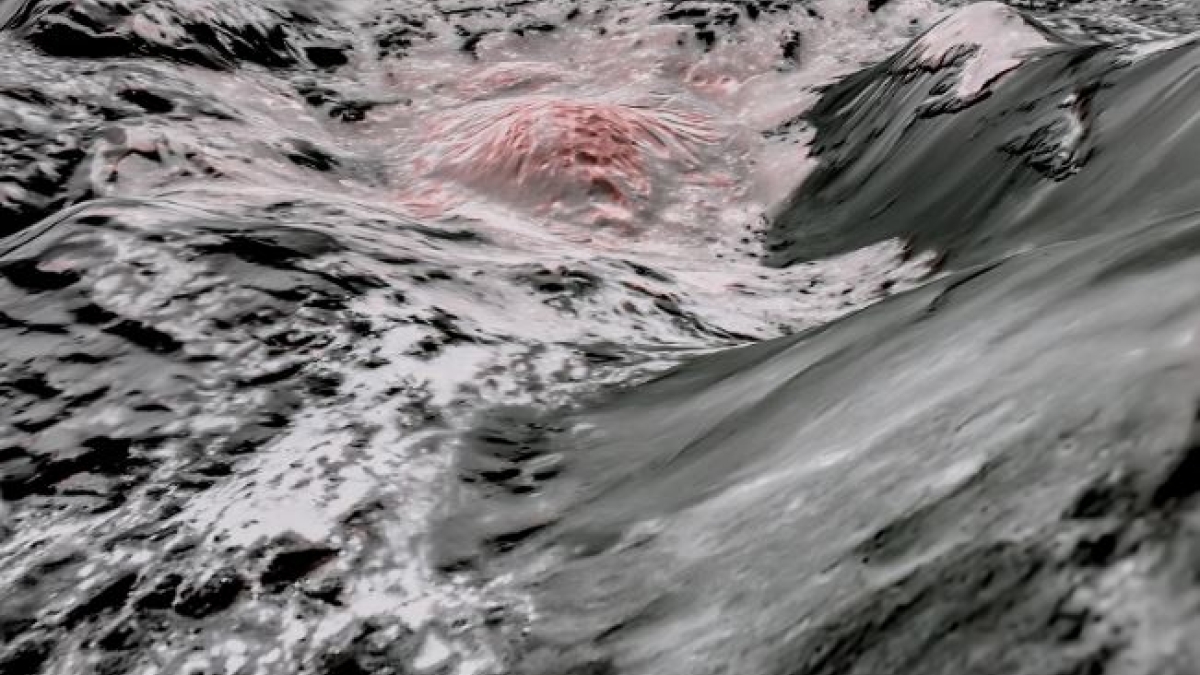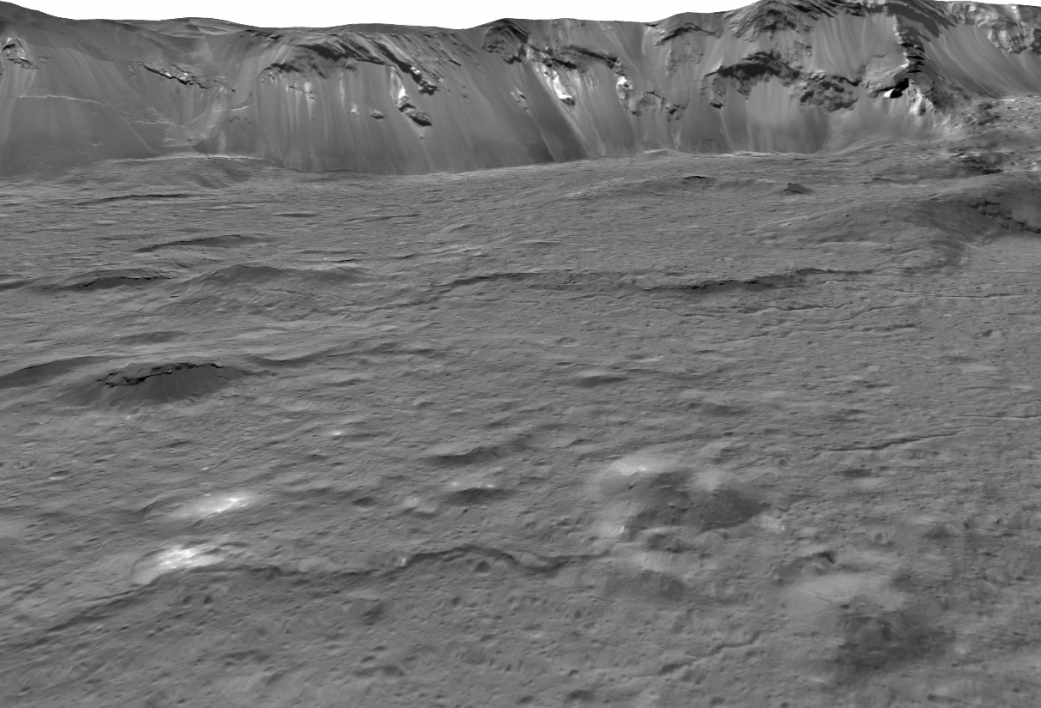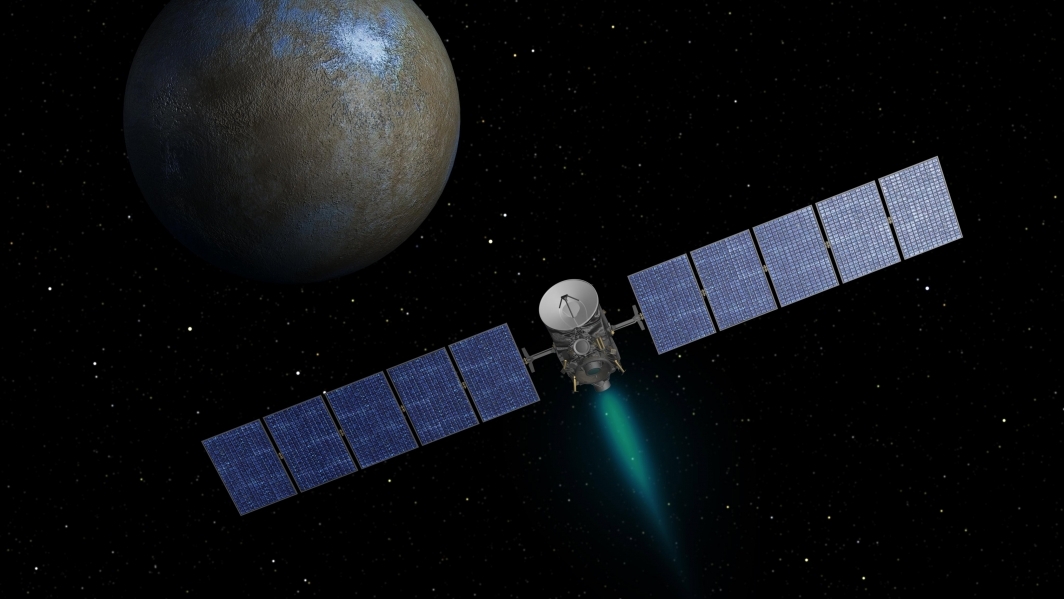Mystery solved: Bright areas on Ceres come from salty water underneath

NASA's Dawn spacecraft captured pictures in visible and infrared wavelengths, which were combined to create this false-color view of a region in 57-mile-wide Occator Crater on the dwarf planet Ceres. Here, recently exposed brine, or salty liquids, in the center of the crater were pushed up from a deep reservoir below Ceres' crust. In this view, they appear reddish. Credit: NASA/JPL-Caltech/UCLA/MPS/DLR/IDA
Data from NASA's recent Dawn mission answers two long-unresolved questions: Is there liquid inside Ceres, and how long ago was the dwarf planet geologically active?
NASA's Dawn spacecraft gave scientists extraordinarily close-up views of the dwarf planet Ceres, which lies in the main asteroid belt between Mars and Jupiter. By the time the mission ended in October 2018, the orbiter had dipped to less than 22 miles above the surface, revealing crisp details of the mysterious bright regions Ceres had become known for.
Scientists had figured out that the bright areas were deposits made mostly of sodium carbonate, a compound of sodium, carbon and oxygen. They likely came from liquid that percolated up to the surface and evaporated, leaving behind a highly reflective salt crust. But what they hadn't yet determined was where that liquid came from.
By analyzing data collected at the end of the mission, Dawn scientists, including planetary scientist David Williams of Arizona State University's School of Earth and Space Exploration, have concluded that the liquid came from a deep reservoir of brine, or salt-enriched water.
By studying Ceres' gravity, scientists learned more about the dwarf planet's internal structure and were able to determine that the brine reservoir is about 25 miles deep and hundreds of miles wide.
Ceres doesn’t benefit from internal heating generated by gravitational interactions with a large planet, as is the case for some of the icy moons of the outer solar system. But the new research, which focuses on Ceres' 57-mile-wide Occator Crater — home of the most extensive bright areas — confirms that Ceres is also a water-rich world, like these other icy bodies.
The findings, which also reveal the extent of geologic activity in Occator Crater, appear in a special collection of eight papers published recently. Williams is a co-author of four of the papers in Nature Astronomy, Nature Geoscience, and two studies in Nature Communications featured here and here.
“We analyzed the final Dawn spacecraft data with every available tool in our tool box: analyses of the shape of geologic features (geomorphology), topography of the surface, counting impact craters for age estimates, geological mapping, etc.,” said Williams, who is the director of the Ronald Greeley Center for Planetary Studies at ASU. “We ended up with a final set of hypotheses to explain Occator’s bright spots. All of them involve the emplacement of a salt and carbonate-rich brine.”
Solving the bright mystery
Long before Dawn arrived at Ceres in 2015, scientists had noticed diffuse bright regions with telescopes, but their nature was unknown. From its close orbit, Dawn captured images of two distinct, highly reflective areas within Occator Crater, which were officially named Cerealia Facula and Vinalia Faculae ("faculae" means bright areas).
Scientists knew that micrometeorites frequently pelt the surface of Ceres, roughing it up and leaving debris. Over time, that sort of action should darken these bright areas. So their brightness indicates that they likely are young. Trying to understand the source of these areas, and how the material could be so new, was a main focus of Dawn's final extended mission, from 2017 to 2018.
The research not only confirmed that the bright regions are young — some less than 2 million years old — it also found that the geologic activity driving these deposits could be ongoing. This conclusion depended on scientists making a key discovery: salt compounds (sodium chloride chemically bound with water and ammonium chloride) concentrated in Cerealia Facula.
“The 57-mile diameter Occator Crater turned out to be the ‘star’ in terms of geologically recent activity on dwarf planet Ceres,” Williams said. “The bright materials observed in this 22-million-year-old impact crater appear to have erupted in the last 2 to 9 million years, indicating there is some internal heat still left in Ceres.”
On Ceres' surface, salts bearing water quickly dehydrate, within hundreds of years. But Dawn's measurements show they still have water, so the fluids must have reached the surface very recently. This is evidence both for the presence of liquid below the region of Occator Crater and ongoing transfer of material from the deep interior to the surface.
The scientists found two main pathways that allow liquids to reach the surface.
"For the large deposit at Cerealia Facula, the bulk of the salts were supplied from a slushy area just beneath the surface that was melted by the heat of the impact that formed the crater about 20 million years ago," Dawn Principal Investigator Carol Raymond said. "The impact heat subsided after a few million years; however, the impact also created large fractures that could reach the deep, long-lived reservoir, allowing brine to continue percolating to the surface."
Active geology: Recent and unusual
In our solar system, icy geologic activity happens mainly on icy moons, where it is driven by their gravitational interactions with their planets. But that's not the case with the movement of brines to the surface of Ceres, suggesting that other large ice-rich bodies that are not moons could also be active.
Some evidence of recent liquids in Occator Crater comes from the bright deposits, but other clues come from an assortment of interesting conical hills reminiscent of Earth's pingos – small ice mountains in polar regions formed by frozen pressurized groundwater. Such features have been spotted on Mars, but the discovery of them on Ceres marks the first time they've been observed on a dwarf planet.
On a larger scale, scientists were able to map the density of Ceres' crust structure as a function of depth — a first for an ice-rich planetary body. Using gravity measurements, they found Ceres' crustal density increases significantly with depth, way beyond the simple effect of pressure. Researchers inferred that at the same time Ceres' reservoir is freezing, salt and mud are incorporating into the lower part of the crust.
“All of the results suggest one or more brine reservoirs within the crust of Ceres, perhaps relics of an ancient ocean on this icy world,” Williams said, who is part of a team developing a mission concept study for a NASA lander and sample return mission to Ceres. “If it comes to fruition, a sample return mission would allow us to bring some of these bright materials to Earth to conclusively determine their origin.”
Dawn is the only spacecraft ever to orbit two extraterrestrial destinations — Ceres and the giant asteroid Vesta — thanks to its efficient ion propulsion system. When Dawn used the last of a key fuel, hydrazine, for a system that controls its orientation, it was neither able to point to Earth for communications nor to point its solar arrays at the sun to produce electrical power. Because Ceres was found to have organic materials on its surface and liquid below the surface, planetary protection rules required Dawn to be placed in a long-duration orbit that will prevent it from impacting the dwarf planet for decades.
"Dawn accomplished far more than we hoped when it embarked on its extraordinary extraterrestrial expedition," said Mission Director Marc Rayman, of NASA's Jet Propulsion Laboratory (JPL) in Southern California. "These exciting new discoveries from the end of its long and productive mission are a wonderful tribute to this remarkable interplanetary explorer."
JPL, a division of Caltech in Pasadena, California, manages Dawn's mission for NASA's Science Mission Directorate in Washington. Dawn is a project of the directorate's Discovery Program, managed by NASA's Marshall Space Flight Center in Huntsville, Alabama. JPL is responsible for overall Dawn mission science. Northrop Grumman in Dulles, Virginia, designed and built the spacecraft. The German Aerospace Center, Max Planck Institute for Solar System Research, Italian Space Agency and Italian National Astrophysical Institute are international partners on the mission team.
This article was written by Gretchen McCartney of NASA’s Jet Propulsion Laboratory with contributions by Karin Valentine, Marketing and Media Relations Manager in the School of Earth and Space Exploration.
More Science and technology

Advanced packaging the next big thing in semiconductors — and no, we're not talking about boxes
Microchips are hot. The tiny bits of silicon are integral to 21st-century life because they power the smartphones we rely on,…

Securing the wireless spectrum
The number of devices using wireless communications networks for telephone calls, texting, data and more has grown from 336…

New interactive game educates children on heat safety
Ask A Biologist, a long-running K–12 educational outreach effort by the School of Life Sciences at Arizona State University, has…

